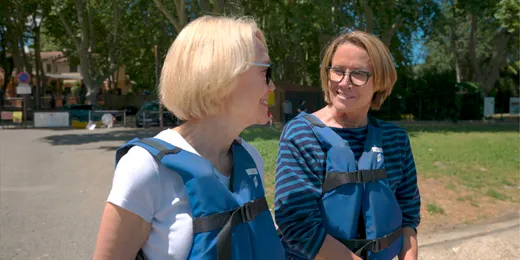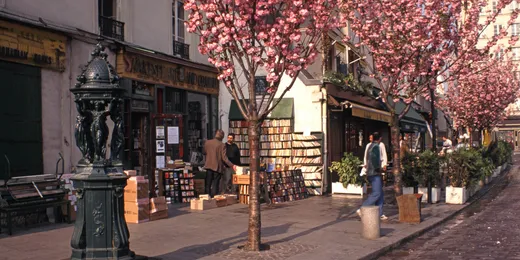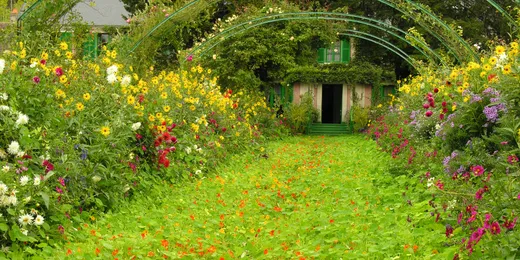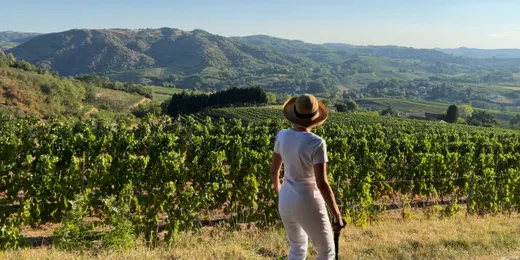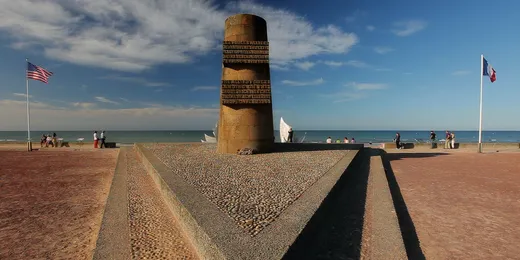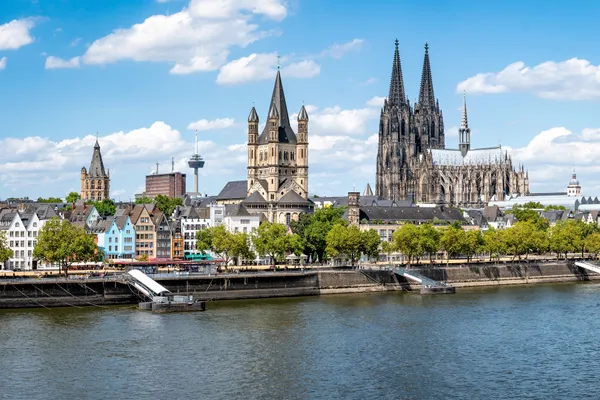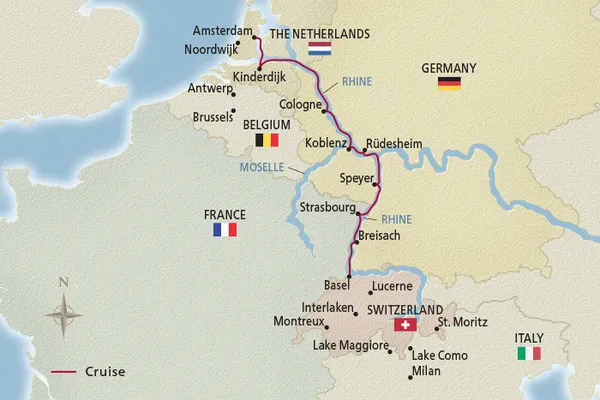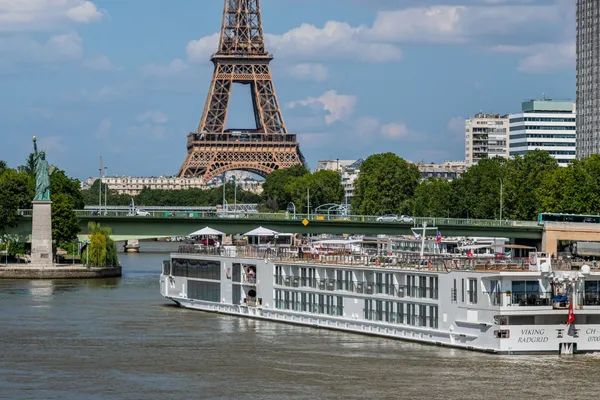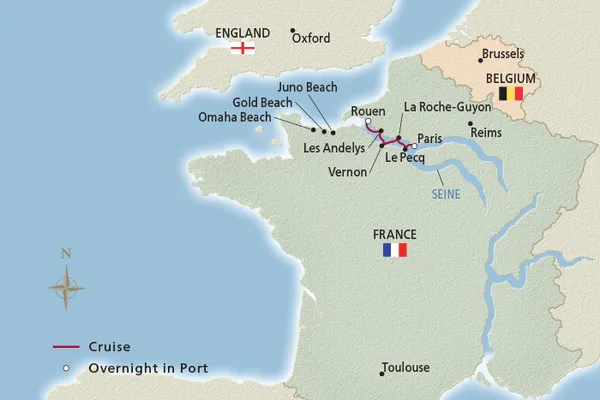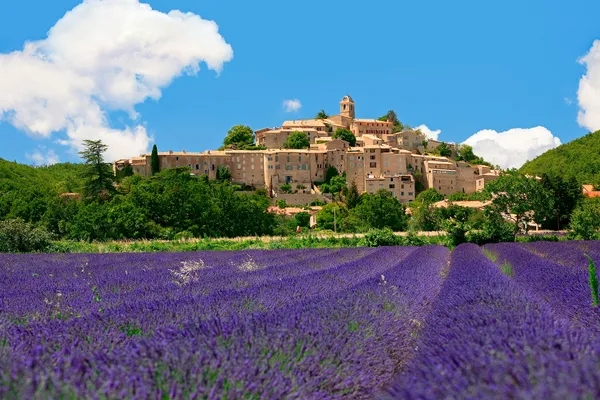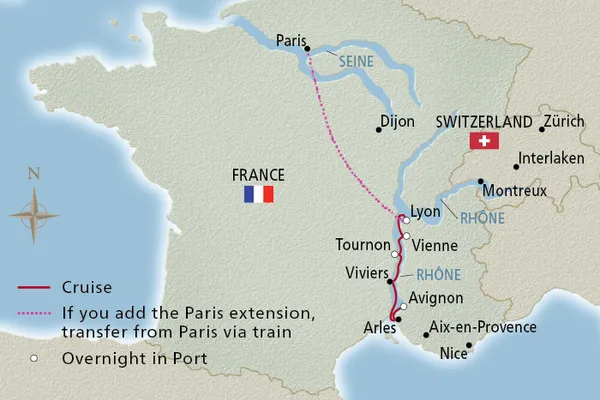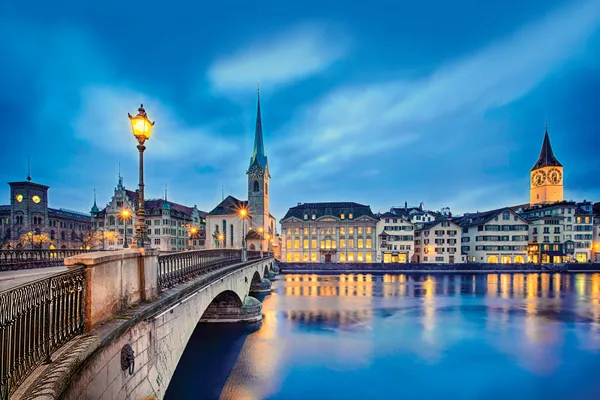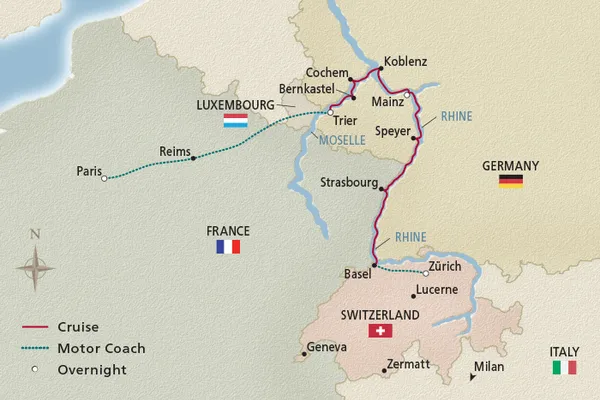
Immerse yourself in the charms of France
France captivates visitors with its world-class wines in Bordeaux and architectural highlights such as Avignon’s grand Palace of the Popes—Europe’s largest Gothic building. Read on to discover France’s rich culinary traditions, showcased in everything from soup to dessert. Then, deepen your understanding of French customs and discover the legendary Seine River.

France
France stands out as a nation in Western Europe by offering a rich blend of culture, history and natural beauty. Roughly the size of Texas and four times that of England, it stretches from the Atlantic to the Mediterranean and shares borders with eight countries, making it a gateway to both northern and southern Europe. Fertile plains, lush forests and dramatic mountain ranges like the Alps and Pyrenees shape its landscape, while its varied climate—from cool and humid in the north to warm and dry in the south—makes it a year-round destination.
France enjoys a temperate climate with four distinct seasons. Average temperatures across France in the winter can range from 36 °F to 45 °F (2 °C to 7 °C), while summer temperatures can fall between 63 °F and 79 °F (17 °C to 26 °C).
From the elegance of its capital city of Paris and the bucolic countryside of Provence to alpine scenery outside of Lyon, France offers something unforgettable for every traveler. Notable landmarks and cultural highlights in France include:
- Eiffel Tower—Civil engineer Gustave Eiffel designed his namesake iron structure and led a team of 132 workers and 50 engineers, who completed the mammoth task in under two years. It served as the grand entrance to the Paris World Exposition of 1889. The Eiffel Tower stands 986 ft. tall (300 m), and millions of visitors climb the structure’s 1,710 steps each year.
- Palace of Versailles—The former residence of Louis XVI and his queen, Marie Antoinette, this opulent palace unabashedly symbolized the power of the absolute monarchy. Of its 700 rooms, the most famous is the Galerie des Glaces, or the Hall of Mirrors. Outside, the renowned landscape architect André Le Nôtre laid a 225-acre garden designed to stretch as far as the king could see, satisfying His Majesty’s view that he even ruled nature.
- Monet’s Gardens—Claude Monet’s masterpiece at Giverny, northwest of Paris, is widely considered one of the world’s most beautiful gardens. Anchored by its iconic Japanese bridge, the water garden blooms throughout the spring with azaleas, wisteria, lily of the valley and the famed water lilies that inspired many of Monet’s paintings.
- Strasbourg Cathedral—Officially called the Cathédrale Notre-Dame de Strasbourg, this cathedral is acclaimed as one of the world’s most beautiful examples of high or late Gothic architecture. With a spire that soars 466 feet into the air, it is the world’s sixth-tallest church and the highest extant building constructed entirely during the Middle Ages.
- Lyonnaise cuisine—Lyon, often hailed as the gastronomic capital of France, is home to both Michelin-starred restaurants and the beloved bouchons Lyonnais—cozy, convivial eateries where locals gather to enjoy hearty, traditional fare, such as Salade Lyonnaise, a warm salad of frisée lettuce, bacon lardons, croutons and a poached egg.

-
Cuisine—3 renowned dishes from France
France’s culinary heritage is a cornerstone of its cultural identity. Recognized by UNESCO in 2010 as an intangible cultural heritage of humanity, the “gastronomic meal of the French” is more than just food—it is a ritual that celebrates community, tradition and artistry. The country is home to the world’s highest number of Michelin-starred restaurants, and the Michelin Guide itself—a globally respected culinary award—originated in France. Prized ingredients come from every corner of France, including butter and apples from Normandy, black truffles from Périgord, goat cheese from the Loire Valley and lavender and olive oil from Provence. These regional specialties reflect the deep connection between French food and its terroir—the unique characteristics of the land.
Here are three popular French foods that visitors may wish to try:
- French onion soup
This heartwarming mélange of caramelized onions, beef stock and sherry with a cap of grilled Comté or Gruyère cheese is a French classic. Onion soup has been a staple food for poor people in almost every national cuisine, but according to legend, it was a French monarch who elevated the humble soupe à l’oignon to something regal. - Coquilles Saint-Jacques
Nestled along the coast of France, Normandy is known for its picturesque fishing villages and fine seafood. Coquilles Saint-Jacques, for example, is a beloved appetizer that features baked scallops served in a creamy sauce and topped with breadcrumbs. - Profiteroles
These filled pastries (also called choux à la crème, cream puffs or éclairs) are rounded mounds of choux pastry dough. Upon baking, they hollow out and then receive a variety of fillings such as whipped cream, custard, ice cream, lemon curd, chocolate mousse, fruit preserves and more. Profiteroles may be left plain or garnished with chocolate ganache, caramel, apricot glaze or a dusting of powdered sugar.
- French onion soup
-
Culture—3 unique French customs
France is known not only for its cuisine and culture but also for its deep-rooted traditions and social etiquette. Understanding a few unique French customs can enhance any visit and help travelers connect more meaningfully with locals.
- French Greetings and Politeness
Politeness is essential in French culture. When meeting someone for the first time, it is customary to say bonjour madame/monsieur (“good day”) and offer a single, firm handshake. Upon leaving, say au revoir (“goodbye”). In shops and restaurants, always greet staff with bonjour or bonsoir (“good evening”) and say au revoir when exiting. Bonne nuit (“good night”) is reserved for bedtime or when leaving someone’s home in the evening. - The Art of the French Kiss Greeting
The French cheek kiss, or la bise, is a well-known custom. While not used during first introductions between adults, it is common among friends and family. Women kiss women and men and men kiss women—but rarely other men unless they are close. The kiss is a light brush of the cheeks with a kissing sound rather than a true kiss. The number of kisses varies by region: two is standard, four is common among friends and six may be exchanged between old acquaintances. Other terms include le bisou (a warmer kiss) and le baiser (a romantic kiss). Though rare today, some older French gentlemen may still greet married women with a hand kiss, known as baise-main. - Dining Etiquette in France
Dining in France is a ritual of manners. If invited to a French home for dinner, do not expect drinks until all guests have arrived—even if some are late. Strong cocktails are uncommon; instead, hosts may offer an aperitif like kir, cognac or champagne. Wait for a toast before sipping, and never pour your own drink (except water). If you are not offered another drink, it is a polite signal that the evening is winding down.
Before a meal, the French say bon appétit (literally “good appetite,” which essentially means “enjoy your meal”), and guests should wait for the host to begin eating. It is courteous to finish everything on your plate. Cheese is traditionally served before dessert, so save room.
- French Greetings and Politeness
-
Science—The iconic Seine River of Paris & beyond
The Seine River, stretching 482 mi. (776 km), is the second-longest river in France and one of the most iconic waterways in Europe. Originating near Dijon in the Burgundy region, the Seine flows northwest through Troyes and into the heart of the French capital, Paris—dividing the city into the famous Right Bank and Left Bank. Landmarks such as the Eiffel Tower and Musée d’Orsay grace the Left Bank, while the Louvre and Sacré-Coeur Basilica highlight the Right Bank.
Beyond Paris, the Seine winds through Rouen before reaching the English Channel at Le Havre. This vital river is dredged to allow oceangoing vessels to dock as far inland as Rouen, 75 mi. (120 km) from the sea. As France’s busiest inland waterway, the Seine plays a crucial role in commerce, connecting the Île-de-France and Normandy regions with the Atlantic Ocean and northern Europe via an extensive canal network.
The Seine River is also a haven for biodiversity. Its banks are home to a variety of wildlife, including grey herons, buzzards, owls, red deer, wild boar and even beavers. The river supports over 30 species of fish, including carp, pike, trout and salmon—once nearly extinct in the Seine but now returning thanks to decades of environmental restoration.
The Seine River offers a rich blend of history, culture and natural beauty—whether visitors wish to explore Paris by boat or journey along its waters by cruise ship to experience the scenic countryside of Normandy.
France Highlights
From riverside ruins and lush vineyards to glittering cities of elegance and grandeur, France’s history and culture await your discovery. Here is a selection of treasures you may experience on a journey through France:
- The elegant architecture of Paris
- Historic Avignon, known as the “City of Popes”
- Lyon’s legendary cuisine
- Normandy’s American Military Cemetery
- Scenic landscapes that inspired Impressionist artists
- Rouen’s spectacular cathedral
- Farms and forests of Aquitaine
- Fine wines of Bordeaux, Beaujolais and Burgundy
- Charming villages and dreamy vistas of Provence
- The medieval wine-growing town of Saint-Émilion
Destination Insight Videos
-
NBC’s Mary Carillo & Viking’s Jean Newman Glock in Provence (3:16)
Join Mary Carillo, former professional tennis player and correspondent for NBC’s coverage of the Olympic Games, and Jean Newman Glock, Viking’s Ambassador-at-Large, as they explore Provence.
-
Shakespeare & Co. (1:57)
Peruse this literary haven in Paris, a favorite of book lovers and renowned authors since 1919. Browse its stacks and learn about the “tumbleweeds” who work and reside here.
-
Monet’s Gardens (1:44)
Join Karine at Giverny as she visits the Japanese bridge, gardens and water lilies that inspired one of history’s great painters, founder of impressionism Claude Monet.
-
Explore the Rhône Valley’s Roman past with Viking’s Nikolas Rabogliatti (32:57)
Take another look at this special episode on the wines of Southern France with Viking Ambassador-at-Large Jean Newman Glock and Nikolas Rabogliatti, Corporate Enrichment & Program Manager at Viking. Together, Jean and Nikolas venture out on an invigorating hike through the vineyards overlooking the Rhône Valley. Enjoy magnificent views of the vine-covered slopes before Jean and Nikolas are rewarded for their efforts with a tasting of the local vintage. Refreshed, Jean then heads to Vienne, where she uncovers Roman history.
-
The Normandy Beaches (3:05)
There are few more pivotal moments in history than the D-Day landings that ushered in the end of World War II. Visit the sacred beaches with Karine and recall the day’s monumental sacrifices.
France Travel FAQ
All-Inclusive Itineraries—France
Choose one of our enriching, all-inclusive voyages and discover the many benefits of exploring in Viking comfort.



